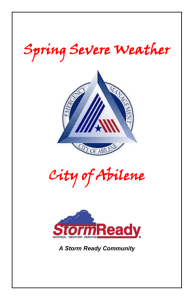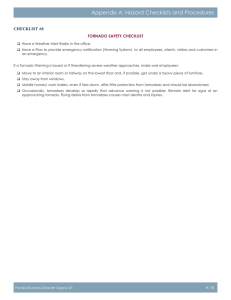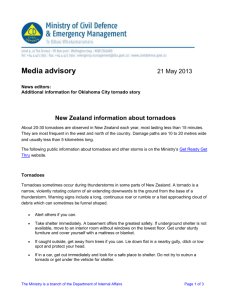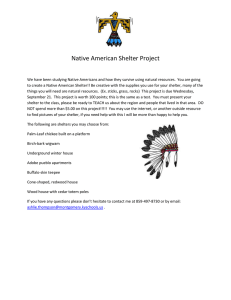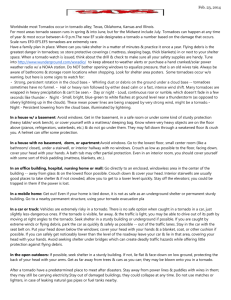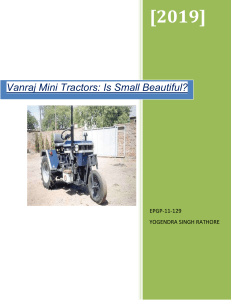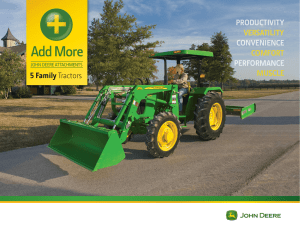Tractor Safety Set 2
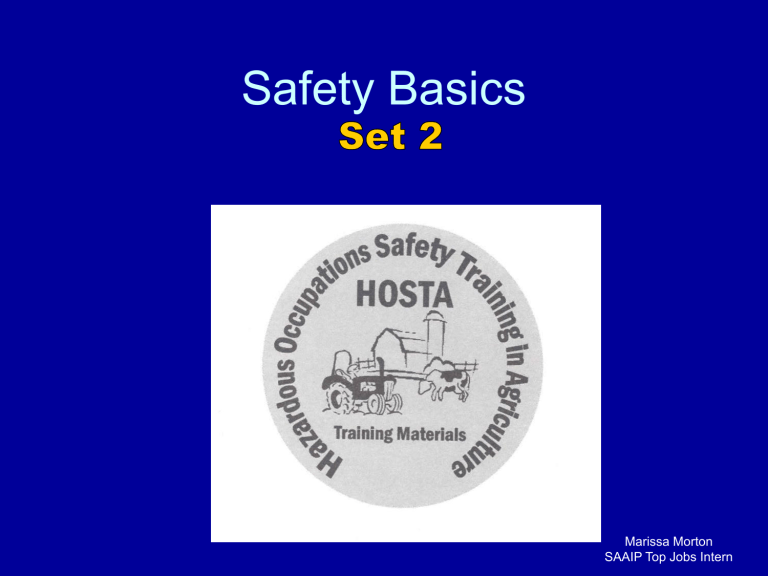
Safety Basics
Marissa Morton
SAAIP Top Jobs Intern
Fatality Facts
• More than 100 youth younger than age 20 are killed each year in farm work related incidents
• Between 1982 and 1996, there were 2,174 farm deaths among youth younger than 20
• 1/3 of the fatalities involved machinery
• Males age 20 and younger accounted for
85% of the fatalities
Injury Facts
• 32,000 youth injuries occurred in 1998 on farms
(44% were work related)
• A rate of 1.2—1.4 injuries/100 youth was reported nationwide
• Falls, animals, and off road vehicle use were three sources of injury
• Hand, head, and leg injuries are most common
• Livestock and dairy farms are top of the list, followed by crop farms
What is Risk?
• Risk: “the chance you take of becoming injured by a hazard”
• Risk measurements are in terms of probability (odds and/or chances)
Reduce Risk
• Recognize your traits that increase risk
• Recognize when more training is necessary to complete a job
• Remove as many hazards from the workplace as possible
• Use safe technology correctly
Reaction Time
• “The time it takes for a person to react to an event or an emergency
• Factors affecting reaction time:
– Experience
– Age
– Fitness
– Fatigue
– Illness
– Pre-occupation
– Distraction
– Mood
– Weather
– Drugs/Medication
– Alcohol and Tobacco
– Machine Vibrations
– Poor Vision
– Poor Hearing
Age Appropriate Tasks
• Age 12-13
– Hand raking/digging
– Limited power tool use with supervision
– Operating lawn mower or garden tractor
– Handling/assisting with animals
– Other low-risk tasks
• Age 14-15
– Equipment
Maintenance
– Manual feeding of livestock
– Operating nonarticulated tractors for fieldwork
– Raking Hay
– Operating a pressure washer
Age Appropriate Tasks
• Age 16-18
– Ordinary use of tractors, self propelled machinery, augers, elevators, and other equipment
– Pulling oversize loads, simultaneous use of multiple vehicles, and applying chemicals
(with proper training) http://www.agdepartment.com/Images/LivestockPollution/tractor.jpg
Severe Weather
• Areas of risk include:
– High Temperatures (heat cramps, heat exhaustion, heat stroke)
– High Humidity (thunderstorms, lightning, tornadoes)
– Winter Weather (Frostbite, Hypothermia, Loss of Traction)
Heat and Cold Protection
• Proper attire should be worn in heat and cold conditions
– Heat: Sunscreen, wide brim hat, bandana, long sleeve shirt, long trousers
– Cold: First layer T-shirt, second layer work shirt, third layer sweater, fourth layer jacket
Lightning, Tornadoes, and Rain
• Check weather forecast
• Observe threatening clouds
• Seek low spots in open fields for shelter
• Use closed buildings for shelter if possible
• Tractors with cabs and vehicles can be used for shelter
• Remain alert to storms if tornado “watch” is issued
• Do not try to outrun a tornado
• Seek a low ditch, face down for tornado shelter
• Go to basements or inner rooms of buildings for shelter
Lightning, Tornadoes, and Rain
• Rain makes fields slippery! Be careful— tractor steps may be muddy and wet fields reduce traction
• Flash flooding can occur
• Accidents during storms occur when workers hurry to get the job done quickly http://www.ipm.iastate.edu/ipm/icm/2004/3-22-2004/palle-seedinoculation.jpg
Housekeeping
• Aisles and pathways should be wide enough and high enough for safe movement
• There should be adequate lighting and ventilation
• Slip resistant floors are a good idea
• Pits and floor openings should be covered
• Sharp edges should be eliminated
• Exits need to be clearly defined
• Sink and toilet facilities should be clean and sanitary
Personal Dress
• Wear snug-fitting clothes
• Leave jewelry at home
• Wear hard shoes with slip-resistant treads…no sandals!
• Tie shoes tight
• Tie long hair back
• Wear long pants at the correct length
• Careful of dangling sleeves, pantlegs, etc.
Hazard Signs, Hand Signals
• Be Aware of what hazard signs are out there and what they mean
• Memorize proper hand signals http://www.cityofames.org/worksweb/Images/Photos/bksigns6.gif
Personal Protective Equipment
• Eye—goggles, face shield
• Respiratory—dust/cartridge mask)
• Head—caps, hard hats
• Hearing—ear plugs, acoustic muff
• Foot—steel toe shoe
• Hand—Gloves
First Aid and Rescue
• Along with safe equipment, a safe work site should have:
– A person trained in CPR
– First Aid kit and supplies
– Emergency plan (with phone numbers)
– Location or site map for emergency responders
First Aid Equipment
• Roller Bandages
• Adhesive Tape
• Sterile First-Aid Dressings and Compresses
(various sizes)
• Disinfectant Soap or Wound Cleaner
• Tweezers
• Scissors
• Latex Gloves
• Directions for Requesting Emergency
Assistance

